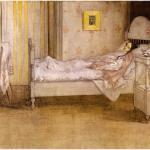Last evening HP called my attention to a recent post on M*. I think I’d like to add a little to the business of er…bloodlines and OT exegesis.
So let’s do a little textual criticism. Here’s the text of Is 48:1:
Hear this, O house of Jacob
who are called by the name of Israel,
who came forth from the waters of Judahwho swear by the name of the Lord
and invoke the God of Israel
but not in truth.
Now in this context, the “waters of Judah” is set parallel to “called by the name of Israel.” The “water” in question is probably semen. But in the BoM (1 Ne 20:1) the passage reads:
Hearken and hear this, O house of Jacob
who are called by the name of Israel
and are come forth out of the waters of Judah
or out of the waters of baptismwho swear by the name of the Lord
and make mention of the God of Israel
yet they swear not in truth nor in righteousness
In the BoM, the phrase “waters of Judah” now appears with the phrase “waters of baptism.” In addition, the critical text suggests “from the belly of Judah” with a note cf Qumran (a) at the appropriate place in the text.
Now let’s take these variant reading seriously and treat this as a normal matter of textual criticism. These are the pertinent questions:
1) What was the original reading?
2) How did the variants arise?
Just in case you don’t have your copy of Metzger handy, here’s a synopsis:
1) The original reading will best explain all the other readings. (This includes the possibility that the original reading does not appear in any extant manuscripts.)
2) The more difficult reading is to be preferred. In other words, scribes will alter things in order to correct errors in grammar, style, diction, or theology. But the weirdest (most difficult) one wins!
3) The shorter reading is to be preferred. In general, scribes seem to have added words—explanatory glosses, better diction, whatever. It is rare to find an example of a scribe removing something except by accident.
4) Harmonization also seems to have exercised a powerful influence on those who copied scripture. Therefore, dissonant readings are to be preferred.
So now…what was the original reading and how did the variants come about?











